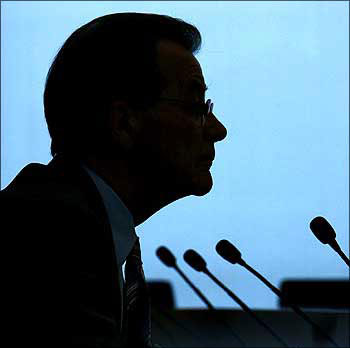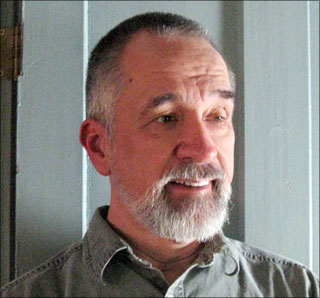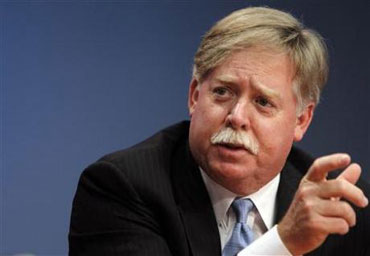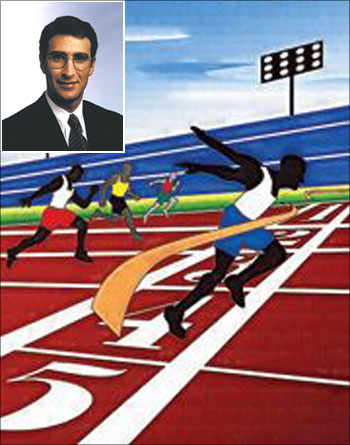
Author of best sellers such as It's Not The Big That Eat The Small - It's The Fast That Eat The Slow, Less Is More, Think BIG - Act Small, Jason Jennings was named by USA Today as one of the three most in-demand business speakers.
His latest work, Hit The Ground Running-A Manual For New Leaders, identifies the ten American CEOs who created the greatest amount of shareholder value between 2000 and 2008, tells their stories and explains the strategies, tactics and values that allowed them to achieve such remarkable performance.
Does Michael Dell have enough mojo to get Dell Computer back on track? Can Howard Schultz reheat Starbucks' sizzle? Will Joe Galli Jr (now CEO at Techtronic) make a successful comeback after being booted from Newell Rubbermaid?
It'll be tough . . . pulling a Steve Jobs is incredibly rare in business. Odds are that most returning CEOs end up like Ted Waitt of Gateway or Jerry Yang of Yahoo.
The same is true of companies. One-time movers and shakers seldom make a comeback. Circuit City couldn't. AOL isn't. Krispy Kreme and Kodak are off the radar. The list of has-beens is longer than most memories.
But it's not just CEOs and companies who face enormous odds creating a great second act. Half of all experienced managers brought in to senior positions fail to deliver as expected and get labeled 'a disappointment'. Remember Carly F., Ed Z., and John T.
. . .

Do you have what it takes to lead a successful comeback?
I analysed all the new CEOs (class of 2000-2007) at the most competitive publicly traded companies in the United States.
I wanted to find those who hit the ground running and uncover how they did it. From my research and interviews I learned critical lessons for leading a comeback, either personally or organisationally.
First let me tell you about these new bosses who all hit the ground running. They're a fascinating mix. Some were insiders and some were outsiders. It didn't matter. They bucked conventional wisdom. All faced huge odds. They are all writing great second acts. Here are three lessons from these top bosses.
. . .

Lesson 1: Become even more adaptable
Howard Lance was picked to take Harris from complacency to outperformer. Lance had spent decades facing the same kinds of challenges at Caterpillar, Emerson and NCR.
But in my interview, when he was being the most candid about his path to this great second act, he said softly, "You ask somebody that knew me twenty years ago, they'd say: 'That's not the Howard I remember.' I'm a different person today. . . otherwise I wouldn't be sitting here."
Adaptability is crucial in any comeback. The world has changed. Most companies and managers need to catch up. But while everybody gives 'willingness to change' a lot of lip service it's so aggravating to let go of your old ways that most people and organisations can't do it.
As one of the best new CEOs put it, "Most people don't have twenty years of experience. They have four years of experience that they've repeated five times!"
Lance figured out how to become even more adaptable at fifty-seven years old than he was at thirty-seven. He wrote his retirement speech. "It [writing a mock retirement speech] made me think: What do I want to be remembered for? What impact do I want to have? And it helped to chart my whole strategy here at Harris."
. . .

Lance's speech had the expected elements of business strategy and performance metrics, but it also had something deeper. Lance searched his soul and really felt what it would be like to create a lasting legacy, to become someone worth talking about.
That led him to examine his deepest motivations. "I want to leave a team that's better than they were, that is inspired and has grown as individuals. And I want to leave, not just as the business leader of this company, but as the voice of this company in the community. I want to earn my reputation as a person of stature."
He concluded, "I want to prove this [my leadership] is sustainable and not just some flash in the pan that the stars aligned and we were great for five years."
Now Lance is well on his way to having that great second act.
. . .

Lesson 2: Ask for help
"We all have heard tales of the leader who charges in on a white horse," a renowned sage of the investment community told me.
"This is the era of the great heroic figure and people look for the man of great talent and splendor who can single-handedly turnaround a troubled business." Of course, this image of a CEO on a white horse is the stuff of fairy tales, he schooled me.
Still a lot of leaders are happy to indulge this outlandish fantasy. Average new bosses go to great lengths to keep up appearances -- they act large and in charge, never asking for help -- all too often to a tragic end for them and their chances of creating a great second act.
Garret Keizer, author of Help, The Original Human Dilemma, explains the hang-up, "There's a tendency in business to act as if a request for help is a deficiency. . . there's an understandable fear that if you let your guard down, you'll be hurt, or that the information you don't know will be used against you.
That's so shortsighted," Keizer explains, "Most individuals want and need to help others and derive pleasure from doing so."
. . .

Mike McCallister, CEO of Humana, knows Keizer is right. He was working at a small hospital when he got his first big opportunity to be the acting administrator of a small hospital. He worried he didn't have all the answers.
Then he says, "A woman who worked in the administrator's office took one look at me and sensed I didn't know what I was doing. She said to me, 'don't worry Hon, I'll show you how to do it.' Every day after that she spent a couple of hours a day teaching me how to run a hospital." McCallister has never been shy again to ask his people for help.
Marshall Larsen, CEO of Goodrich, says that any accomplished business leader has to count on other people and be upfront about asking for help. "What I need to have are people who aren't afraid to look me in the eye and tell me I'm wrong," he says.
"Unless a CEO asks for the help of others," he adds, "and is prepared to listen to the people around him, eventually the organisation will suffer from 'group think' and he'll lead them all off a cliff like Lemmings."
All of CEOs I studied asked for help. They reached out to their boards, their leadership circles, their front line employees, and their families. Not one saw this as a sign of weakness. Not one buys into the fantasy of the CEO who can single handedly turn around a multi-billion dollar enterprise.
"Any CEO that thinks he pulled all the strings and made everything happen is kidding himself," Marshall Larsen said.
The odds against a successful second act will go down significantly if you ask for help.
. . .

Lesson 3: Keep it simple
Jeffrey Lorberbaum took charge at Mohawk he says because, "Nobody wanted the job." He was kidding of course, but there was some truth in his joke.
Mohawk had made fourteen key acquisitions in eight short years that led to explosive growth at the carpet manufacturer. Lorberbaum's former company, Aladdin Mills, was one of them.
When you increase the size of your business ten times through a blitz of acquisitions you bring on a lot of complications. Integration of different plants, processes, and personalities was such a monumental headache for whoever took the reins at Mohawk that Lorberbaum quipped, "Nobody wanted the job."
But Lorberbaum was able to tame the stampede of competing cultures, complications, and cutthroat competition in the carpet and flooring industry and create a great second act for himself and Mohawk. His secret -- keep it simple or as he says, "Oversimplify everything."
The second advantage comes as your teams are executing the plan. "When you design large steps, he says, "they're often so large that the troops can't follow them. The people can't execute it. They lose sight of the most important thing and they screw it up." "So the approach we always take," Lorberbaum says, "is try to define some step that everyone can swallow. Simplifying forces you to think it through."
The most conservative estimate says that half of all strategies fail. But that's not because they were bad ideas. Most of the time strategies fail because they didn't get enough follow through. Complexity kills follow-through. Keeping everything simple is the right medicine.
Making a comeback isn't easy. If it were everybody would be doing it. But each of these steps are simple. And they work!